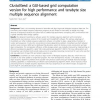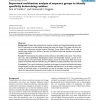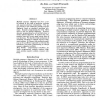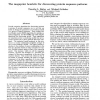116
Voted
BMCBI
2010
15 years 18 days ago
2010
Background: There is an increasing demand to assemble and align large-scale biological sequence data sets. The commonly used multiple sequence alignment programs are still limited...
112
Voted
BMCBI
2007
15 years 18 days ago
2007
Background: Proteins that evolve from a common ancestor can change functionality over time, and it is important to be able identify residues that cause this change. In this paper ...
121
click to vote
BMCBI
2008
15 years 18 days ago
2008
Background: Multiple sequence alignments are a fundamental tool for the comparative analysis of proteins and nucleic acids. However, large data sets are no longer manageable for v...
117
click to vote
BMCBI
2010
15 years 18 days ago
2010
Background: While most multiple sequence alignment programs expect that all or most of their input is known to be homologous, and penalise insertions and deletions, this is not a ...
111
Voted
BMCBI
2010
15 years 18 days ago
2010
Background: Determining beforehand specific positions to align (anchor points) has proved valuable for the accuracy of automated multiple sequence alignment (MSA) software. This f...
94
Voted
BMCBI
2010
15 years 18 days ago
2010
Background: A widely used method to find conserved secondary structure in RNA is to first construct a multiple sequence alignment, and then fold the alignment, optimizing a score ...
95
Voted
BIB
2008
15 years 18 days ago
2008
The accuracy and scalability of multiple sequence alignment (MSA) of DNAs and proteins have long been and are still important issues in bioinformatics. To rapidly construct a reas...
101
click to vote
ISMB
1994
15 years 1 months ago
1994
Multiple sequence alignment has been a useful methodin the study of molecular evolution and sequence-structure relationships. This paper presents a newmethodfor multiple sequence ...
109
Voted
ISMB
1996
15 years 1 months ago
1996
Multiple sequence alignment of distantly related viral proteins remains a challenge to all currently available alignment methods. The hidden Markovmodel approach offers a new,flex...
ISMB
1996
15 years 1 months ago
1996
Several computeralgorithms for discovering patterns in groups of protein sequences are in use that are basedon fitting the parametersof a statistical model to a group of related s...




